Today we are taking a look at Rube Goldberg cartoons. Rube is famous for his cartoons and comic strips. He was a prolific cartoonist, creating over 50,000 cartoons in his career!
Most people are familiar with his Rube Goldberg Machine style comics, but he actually drew other types as well.
The original cartoons are very interesting to look at. There are so many details, especially in his machine comic strips.
I am going to share some comic strips done by him so you can see the wide variety.
We have been writing about Rube Goldberg Ideas for a while now, so be sure to check out all of our articles.

Rube Goldberg Cartoons
Let’s answer a few questions about his cartoons before we get into his actual work. Creative people are fascinating and he was certainly no exception.
Why Did Rube Goldberg Draw Cartoons?
Rube actually wanted to be an artist all his life but his parents did not think that was a lucrative profession and they made him attend college for engineering.
He drew, in part, because it was what his passion was. After college and starting his job drawing sewer pipes, he knew he was not cut out for that type of job and left to go to a newspaper.
He drew sports cartoons there but they were not well-received and very few ended up in the paper.
He didn’t give up though and drew many different types of cartoons throughout his career.
His most famous cartoons came about because of his engineering background and his skepticism of technology. He felt people were creating complicated devices to do very simple tasks and thus his comics featuring contraptions and machines were born.
Here is a quote from him on machines: “the machines are a symbol of man’s capacity for exerting maximum effort to achieve minimal results”.
How Long Did It Take Him to Draw One Cartoon?
Numerous sources say that it took him 30 hours to draw one cartoon. (Wow!)

What Was Rube Goldberg’s Most Famous Cartoon?
His most famous character is Professor Butts. Actually it was Professor Lucifer Gorgonzola Butts to be exact.
His first Rube Goldberg machine style comic was titled Automatic Weight Reducing Machine and was published in 1914.
His most famous cartoon, the most well-known today by far, is the Self-Operating Napkin.
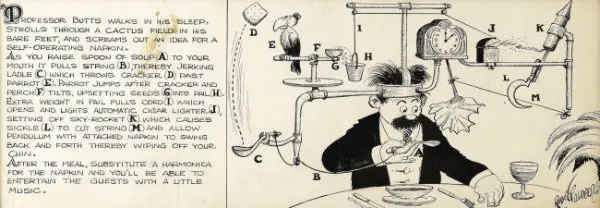
Self-Operating Napkin
In Self-Operating Napkin, “Professor Butts walks in his sleep, strolls through a cactus field in his bare feet, and screams out an idea for a self-operating napkin. As you raise spoon of soup (A) to your mouth it pulls string (B), thereby jerking ladle (C) which throws cracker (D) past parrot (E). Parrot jumps after cracker and perch (F) tilts, upsetting seeds (G) into pail (H), extra weight in pail pulls cord (I) which opens and lights automatic cigar lighter (J), setting off sky-rocket (K) which causes (L) to cut string (M) and allow pendulum with attached napkin to swing back and forth thereby wiping off your chin. After the meal, substitute a harmonica for the napkin and you’ll be able to entertain the guests with a little music.”
Here is another machine comic: If the Soap Falls Out of the Bathtub, Try This –

If the Soap Falls Out of the Bathtub, Try This–, Nov 18 1921, Duluth Herald
In If The Soap Falls Out of the Bathtub, Try This–, “Man in bath tub snaps fingers and pet golf-beaked soap-hawk (A) hits soap (B) into baseball glove (c) – Rebound of spring (D) causes glove to throw soap past cat (E) into trough (F) – Breeze from flying soap causes cat to catch cold – she sneezes, blowing soap off trough- Soap hits string (G), which pulls trigger of pistol (H), shooting ram (I) against small car (J), into which soap has meantime fallen- Car carries soap up platform (K), dumping it back into tub and man can continue with his bath.”
The Rube Goldberg Machine actually had its start as The Inventions of Professor Lucifer Gorgonzola Butts drawings.
If the Soap Falls Out of the Bathtub, Try This – has a side comic panel of Foolish questions as well. Which brings us to the next comics.
Foolish Questions
Before he started writing what came to be known as the Rube Goldberg machine cartoons, he wrote Foolish Questions single panel comics in the New York Evening Mail. Starting with number 1, October 23, 1908 he proceeded to write thousands more.
While Rube started out as a sports cartoonist, he then wrote his first cartoon called “Foolish Question No. 1” which took off and sent him on a new path. Foolish Question comics were a hit among newspaper readers who even sent in their own questions for him to answer.
Here are a couple examples:
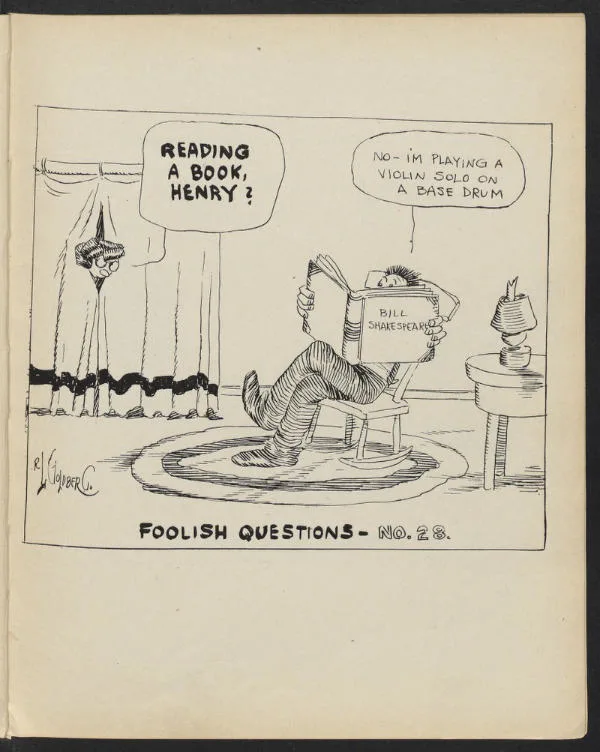
Foolish Questions No. 26, Harvard Library, 1909
“Reading a book, Henry? No, I’m playing a violin solo on a bass drum.”
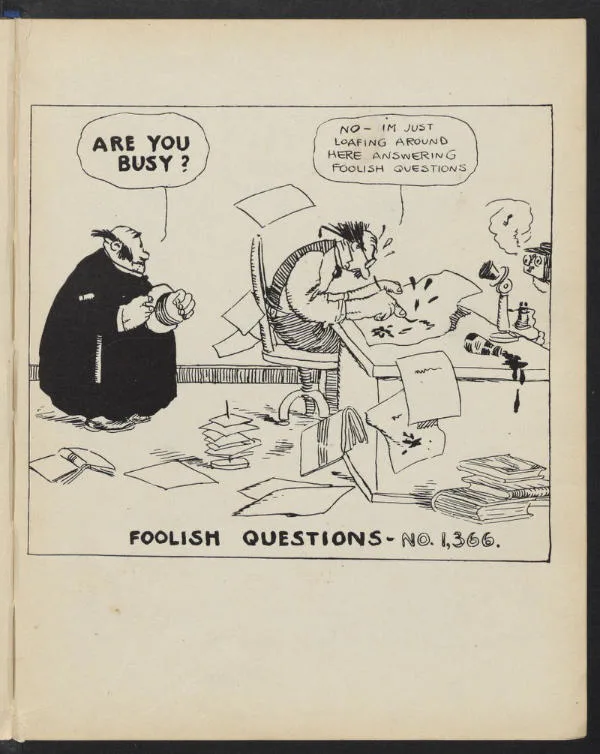
Foolish Questions No. 1366, Harvard Library, 1909
I especially love this one because it is a self-portrait of Rube Goldberg writing Foolish Questions while answering a foolish question. You can’t get much better than that! Ha!
“Are you busy? No, I’m just loafing around here answering foolish questions.”
The premise for Foolish Questions is that people ask such obvious questions that they are basically dumb to ask. He decided to play on that and offer equally crazy answers.
Mike and Ike (They Look Alike)
Introduced in September of 1907, Mike and Ike is a comic strip of identical twins who were known as morons.

Mike & Ike Comic Strip April 25, 1922
This strip appeared in the Washington Times.
The J. Wellington Wimpy from the Popeye comics looks quite similar to Mike and Ike in my opinion.
Boob McNutt Comic Strip
This strip was written beginning in 1915 and ending in 1934.
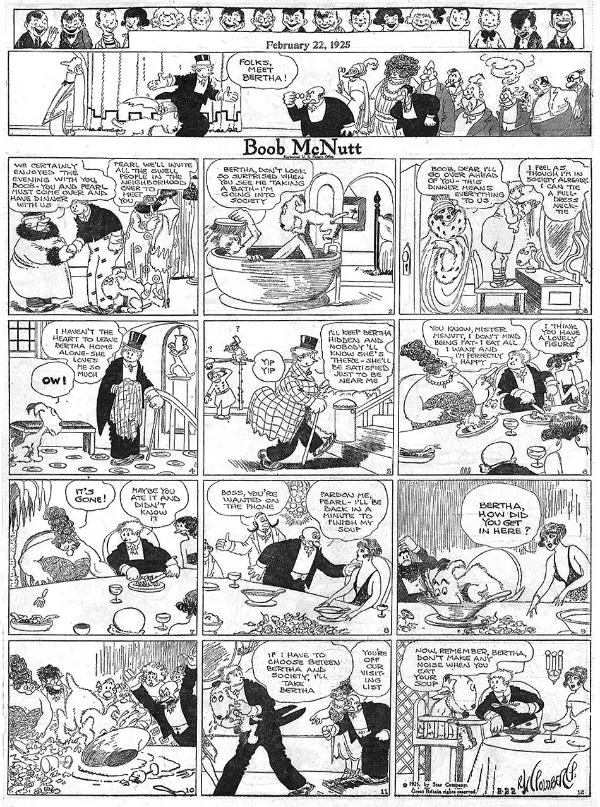
Boob McNutt Comic Strip by Rube Goldberg Feb 22 1925
A foolish character (it seems Rube Goldberg was drawn to drawing strips about them) Boob McNutt and his on-again off-again relationship with his wife – ex-wife was a bit of a drama full of silliness and stumbles.
One could describe him as a fellow with a good heart but sorta dumb as a brick.
Puck Magazine Comics by Rube Goldberg
The Lawyer. “And They Get Away With It”

The Lawyer. “And They Get Away With It” PUCK, October 24, 1914
This comic appeared in Puck, the first humor magazine.
It is of about a man who seeks advice from a lawyer and gets stuck with a big fee for a lot of hot air. It is a bit hard to read here. Here is the link to the Library of Congress record.
Can a College Man be Successful in Spite of His Education?
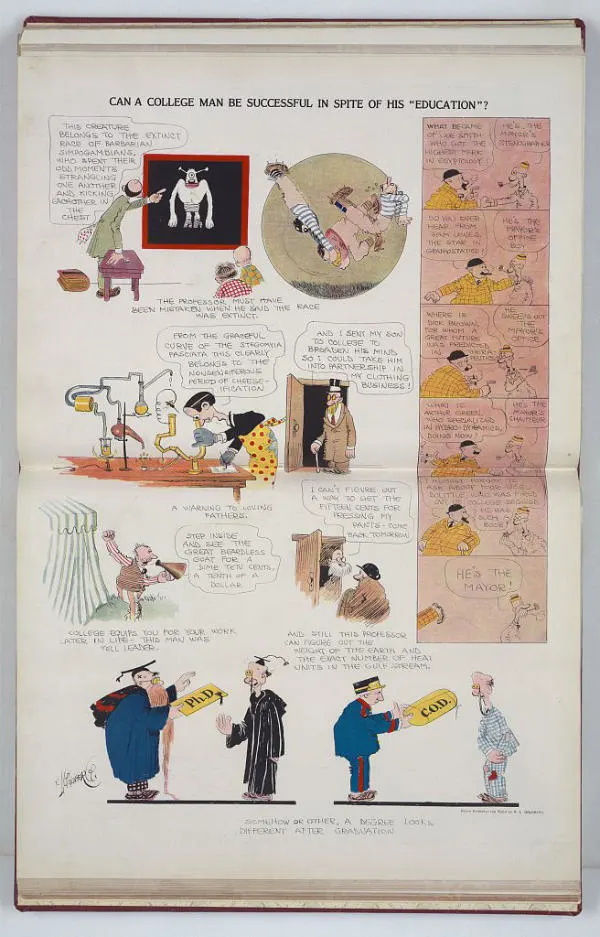
Can a College Man be Successful In Spite of His Education, PUCK Magazine, November 14, 1914
A riff on how “well” a college education makes a person prepared for real life.
Rube Goldberg’s Boobs

Boobs Cartoon Strip, August 22, 1919
Experts give opinions to help remedy high cost of living. This cartoon has five different amusing takes on how to survive with less. The side panel cartoon, No Brains, is also funny.
Additional Cartoons by Rube Goldberg
Pathe Magazine Cartoon Film

Advertisement in Moving Picture World, July 1916
It looks like another self portrait. I can’t find out a whole lot about this one but it was in Pathe magazine and referenced an upcoming animated Goldberg cartoon.
The Ancient Order of The Glass House Postcard
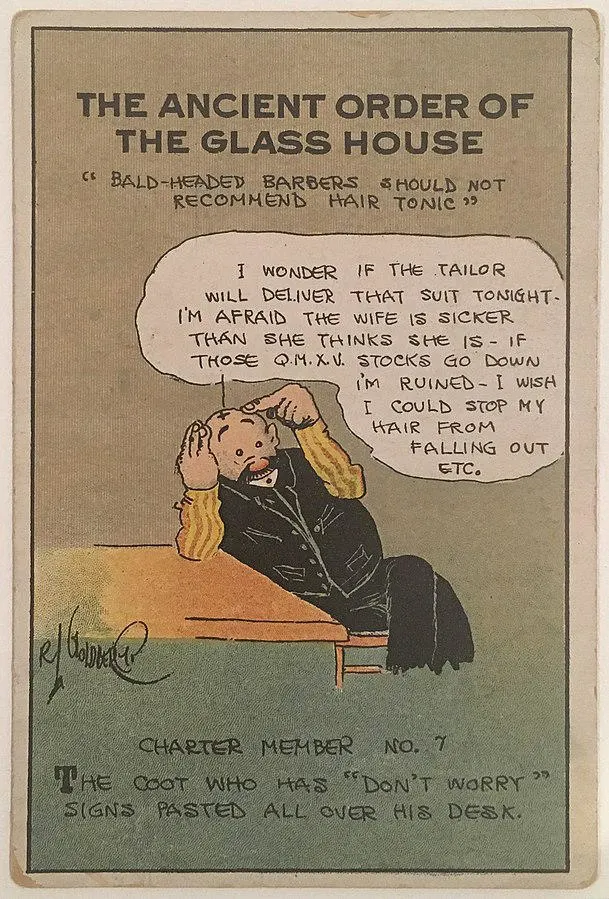
Rube Goldberg Postcard, circa 1910
This is one of his postcards from 1910 featuring a worrier. He certainly had his finger on what people did and what they were like.
The Literary Digest Editorial Cartoonists Self-Portraits
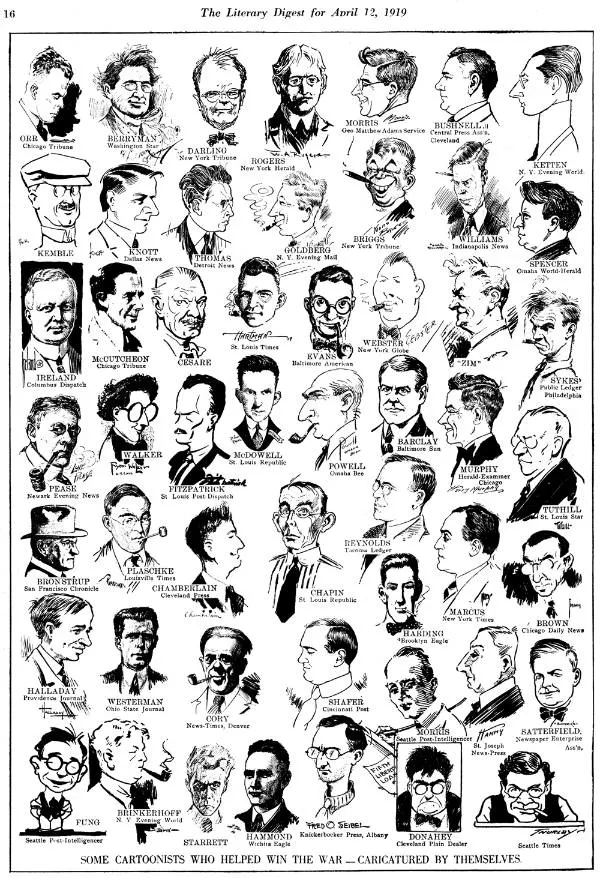
April 12, 1919 Self Portrait, Rube Goldberg
The Literary Digest put out a collection of self portraits from 52 different editorial cartoonists. They captioned it “Some cartoonists who helped win the war.”
Can you spot Rube in the mix? (to learn more about all of them go here.)
Rube Goldberg Drawing Cartoons at His Desk

Rube Goldberg working at his desk, June 30, 1918
Here he is working at his desk. I wonder what cartoon he is drawing!
According to the Rube Goldberg website he created many other comics as well.
They include: The Weekly Meeting of the Tuesday Women’s Club, Lunatics I Have Met, The Candy Kid, Lala Palooza, Sideshow, Father Was Right, I’m the Guy, and They all Looked Good When They Are Far Away.
Because most of them are not in the public domain, I was not able to share actual comic images with you. However, I did want to include the names of each strip so as to be thorough, and so that you could look them up if you wish.
If you would like to learn more about Rube try our Who Was Rube Goldberg article or our overview of Rube Goldberg Books which have a lot of his cartoons and comic strips featured.
